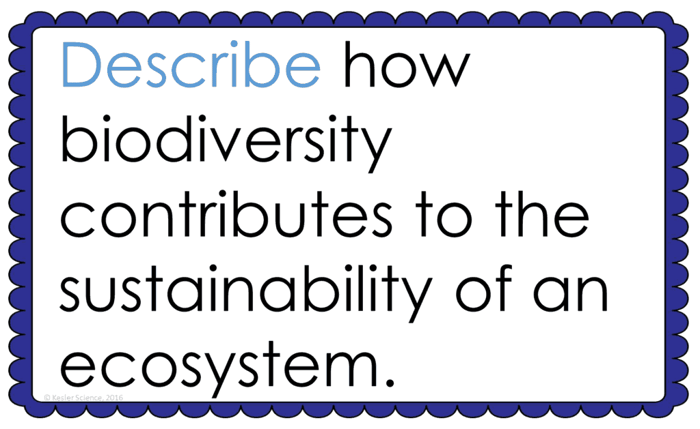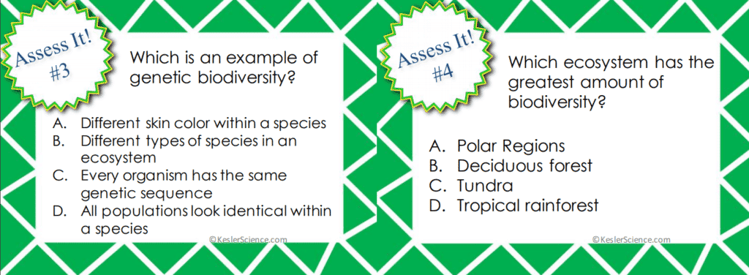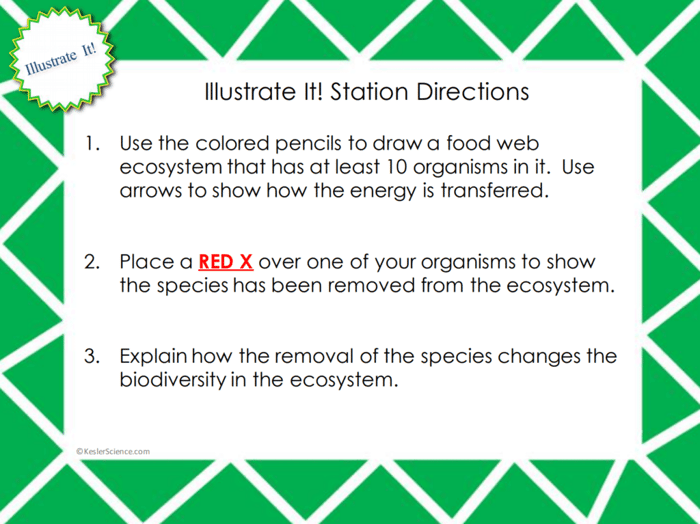BIODIVERSITY LESSON PLAN – A COMPLETE SCIENCE LESSON USING THE 5E METHOD OF INSTRUCTION
At the end of this comprehensive biodiversity lesson plan, students will be able to describe how biodiversity contributes to the sustainability of an ecosystem. Each lesson is designed using the 5E method of instruction to ensure maximum comprehension by the students.
The following post will walk you through each of the steps and activities from the biodiversity lesson plan.
ENGAGEMENT
At the beginning of the lesson, the class will do a Think-Pair-Share to discuss the objective. Students will discuss biodiversity as they try to connect it to prior learning. Students will then be instructed to watch a 4-minute video about biodiversity and make a list as to why it is important. Teacher and students will then cover relevant vocabulary. The teacher will help to clear any misconceptions about the implications of losing a species and why we should, in fact, worry when animal or plant species go extinct.
The teacher will help to clear any misconceptions about the implications of losing a species and why we should, in fact, worry when animal or plant species go extinct.
Estimated Class Time for the Engagement: 20-30 minutes
EXPLORATION
This student-centered station lab is set up so students can begin to explore biodiversity. Four of the stations are considered input stations where students are learning new information about biodiversity, and four of the stations are output stations where students will be demonstrating their mastery of the input stations. Each of the stations is differentiated to challenge students using a different learning style. You can read more about how I set up the station labs here.
EXPLORE IT!
Students will be working in pairs to observe 2 different ecosystems. Students will describe differences between the two ecosystem populations and identify which is more diverse. Once students have completed their observations, they will then be asked to infer the outcomes of each ecosystem if certain species were to be removed.
WATCH IT!
At this station, students will be watching an 8-minute video describing biodiversity. The video will give the students a detailed description of what biodiversity is. The video will show students the importance and value of having a healthy biodiversity in an ecosystem. Students will then answer questions related to the video and record their answers on their lab station sheet.
RESEARCH IT!
The research station will allow students to get online and look up why biodiversity is so important. Students will be researching why biodiversity helps: contribute to the evolution of species, the sustainability of food webs, and the importance to human society. With each concept, students will answer a few questions to help make the research more concrete.

READ IT!
This station will provide students with a one page reading about the biodiversity of living things. In the reading, students will discover how biodiversity can affect ecosystems that come in many different sizes. Ecosystems as huge as the tropical rainforest, to as small as a drop of pond water. Students will then answer 4 multiple choice questions like describe biodiversity, identify a classification of species, provide examples of genetic diversity, and write differences between genetic and ecological biodiversity.
ASSESS IT!
The assess it station is where students will go to prove mastery over the concepts they learned in the lab. The questions are set up in a standardized format with multiple choice answers. Some questions include: which choice best describes biodiversity, which choice is NOT a benefit of biodiversity, what is genetic biodiversity, and finally, which ecosystem has the greatest amount of biodiversity?

WRITE IT!
Students who can answer open-ended questions about the lab truly understand the concepts that are being taught. At this station the students will be answering three questions like explain biodiversity, how does biodiversity support an ecosystem, and describe the difference in biodiversity between a rainforest and arctic tundra.
ILLUSTRATE IT!
Your visual students will love this station. Students will be illustrating a food web that contains 10 organisms it in and use arrows to show the flow of energy. Students will have to place a red "X" over one of the organisms and then explain how that would impact their food web ecosystem.
ORGANIZE IT!
The organize it station allows your students to see a map that shows the many biomes that make up the Earth. Students will determine where the most biodiverse ecosystems are and where the biomes are that are the least biodiverse.
Estimated Class Time for the Exploration: 1-2, 45 minute class periods
EXPLANATION
The explanation activities will become much more engaging for the class once they have completed the exploration station lab. During the explanation piece, the teacher will be clearing up any misconceptions about biodiversity with an interactive PowerPoint, anchor charts, and interactive notebook activities. The biodiversity lesson includes a PowerPoint with activities scattered throughout to keep the students engaged.
The students will also be interacting with their journals using INB templates for biodiversity. Each INB activity is designed to help students compartmentalize information for a greater understanding of the concept. The biodiversity INB template will challenge the students to understand and visualize the importance of having a high biodiversity within an ecosystem.
Estimated Class Time for the Exploration: 2-3, 45 minute class periods
ELABORATION
The elaboration section of the 5E method of instruction is intended to give students choice on how they can prove mastery of the concept. When students are given choice the ‘buy-in’ is much greater than when the teacher tells them the project they will have to create. Each of the biodiversity projects will allow students to explain how biodiversity can support life within an ecosystem.Estimated Class Time for the Elaboration: 2-3, 45 minute class periods (can also be used as an at-home project)
EVALUATION
The final piece of the 5E model is to evaluate student comprehension. Included in every 5E lesson is a homework assignment, assessment, and modified assessment. Research has shown that homework needs to be meaningful and applicable to real-world activities in order to be effective. When possible, I like to give open-ended assessments to truly gauge the student’s comprehension.
Estimated Class Time for the Elaboration: 1, 45 minute class period
DOWNLOAD THE FULL LESSON NOW
The full lesson is available for download from the Kesler Science Store. Save yourself a ton of time and grab it now.
Download Over $100 in FREE Resources
For Middle School Science
Simply create a login below and gain immediate access to a selection of our Kesler Science product line worth $100 - for FREE. There's a full version of every product type! You'll also join tens of thousands of middle school science teachers who receive timely tips and strategies straight to their inbox.




